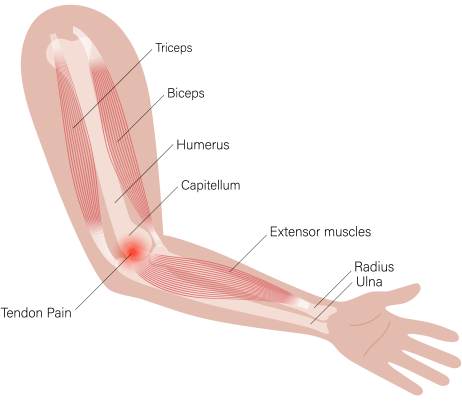Golfer's Elbow Treatment in New Jersey
Golfer's elbow, or medial epicondylitis, is an orthopedic condition that can hamper a wide range of arm movements and cause significant discomfort during activity. At RWJBarnabas Health, we understand that injuries like golfer's elbow resulting from repetitive wrist and arm motions require the care of experienced professionals for effective management and recovery. Our orthopedic specialists in New Jersey are committed to providing personalized care.
What Is Golfer’s Elbow?
Golfer's elbow is caused by overuse of the muscles in the forearm that allow you to grip, rotate your arm, and flex your wrist. Repetitive flexing, gripping or swinging can create pulls or tiny tears in the tendons.

Golfer’s Elbow Causes
Golfer's elbow is typically associated with activities that require gripping or wrist flexion, leading to pain on the inside of the elbow. The discomfort may range from mild soreness to acute pain, depending on the activity level and the duration of the condition.
Several factors can elevate the risk of developing golfer's elbow, a form of tendonitis that affects the inner elbow and forearm. Understanding these risks is crucial for prevention and early intervention:
- Age. Aging can reduce the elasticity and resilience of tendons, increasing susceptibility to tendonitis.
- Overuse. Repetitive wrist and finger motions can strain the muscles and tendons, leading to golfer's elbow.
- Excessive force. Activities that require forceful finger and wrist actions, such as throwing sports or weightlifting, can contribute to the condition.
- Lack of muscle flexibility or strength. Inadequate flexibility and strength in the forearm muscles can increase the strain on the elbow during repetitive movements.
- Sports participation. Golf, baseball and other sports that involve gripping and swinging can put players at higher risk for golfer's elbow.
- Improper technique. Using incorrect form during sports or work-related activities can put additional stress on the elbow tendons.
- Previous injury. Prior elbow injuries or inflammation can predispose individuals to golfer's elbow.
- Occupational hazards. Jobs that involve repetitive arm motions or gripping tools can increase the risk of developing golfer's elbow.
- Certain diseases. Conditions like rheumatoid arthritis or gout can affect the joints and tendons, potentially leading to golfer's elbow.
Golfer’s Elbow Symptoms
Symptoms typically include:
- Pain and tenderness on the inside of the elbow
- Stiffness or weakness in the hands and wrists
- Difficulty with movements such as holding objects, turning doorknobs or shaking hands
Golfer’s Elbow Diagnosis
To diagnose Golfer's elbow, an orthopedic specialist will conduct a thorough examination that may include:
- Medical history. Review any previous injuries, current symptoms and overall health condition.
- Palpation. Identifying areas of tenderness and swelling around the inner elbow.
- Range of motion tests. Assessing the mobility of the elbow and wrist to locate the source of pain.
- Strength testing. Evaluating the strength of the forearm muscles and the stability of the elbow.
- Observing movement patterns. Watching how the patient moves their arm and elbow during activity.
- Imaging tests. Using X-rays, MRI, or ultrasound to obtain a detailed view of the elbow's soft tissues.
Golfer’s Elbow Treatment in New Jersey
Effective management of golfer's elbow is essential to resuming an active lifestyle and maintaining the health of your arm joints. We tailor treatment plans to the severity of each patient's condition, which may include conservative methods as well as advanced interventions. Our treatment options often consist of:
- RICE technique. Rest, ice, compression and elevation (RICE) can reduce inflammation and alleviate pain in the elbow.
- Bracing. Using a supportive golfer’s elbow brace limits movement and gives the tendons time to heal.
- Physical therapy. Designing specific golfer’s elbow exercises to strengthen the forearm muscles and improve the elbow's range of motion.
- Medications. Providing anti-inflammatory drugs, both prescription and over-the-counter, to reduce pain and swelling. In some cases, corticosteroid injections will be recommended to manage inflammation.
- Surgery. In some cases, surgery may be indicated to alleviate golfer's elbow pain.
Should nonsurgical treatments not provide the expected improvement, our expert surgeons are prepared to perform procedures that may include tendon debridement or repair. Furthermore, we offer innovative treatments such as platelet-rich plasma (PRP) therapy among other regenerative medicine techniques to promote tissue healing and speed up recovery.
Golfer’s Elbow Recovery and Rehabilitation
The duration of recovery from golfer's elbow can vary significantly. While mild cases may improve within a few weeks, more severe conditions, particularly those necessitating surgical intervention, may require extensive orthopedic rehabilitation. Our customized rehabilitation programs are structured to yield the best results and enable a quick return to everyday activities.
Rehabilitation is essential in the healing process for golfer's elbow. Our orthopedic team creates individualized recovery plans that may include:
- Targeted exercises. Strength and flexibility in the forearm and wrist will gradually return.
- Stretching and strengthening routines. The range of motion and muscle support in the affected area is the focus.
- Motor control and stability training. Training is encouraged to improve arm function and prevent future injuries.
Expert Care for Golfer’s Elbow
For those facing golfer's elbow in New Jersey, RWJBarnabas Health stands as a leader in orthopedic care. We are the state's largest and most comprehensive academic health care system, offering award-winning services. Our highly skilled, board-certified orthopedic specialists provide expert care for golfer's elbow.



